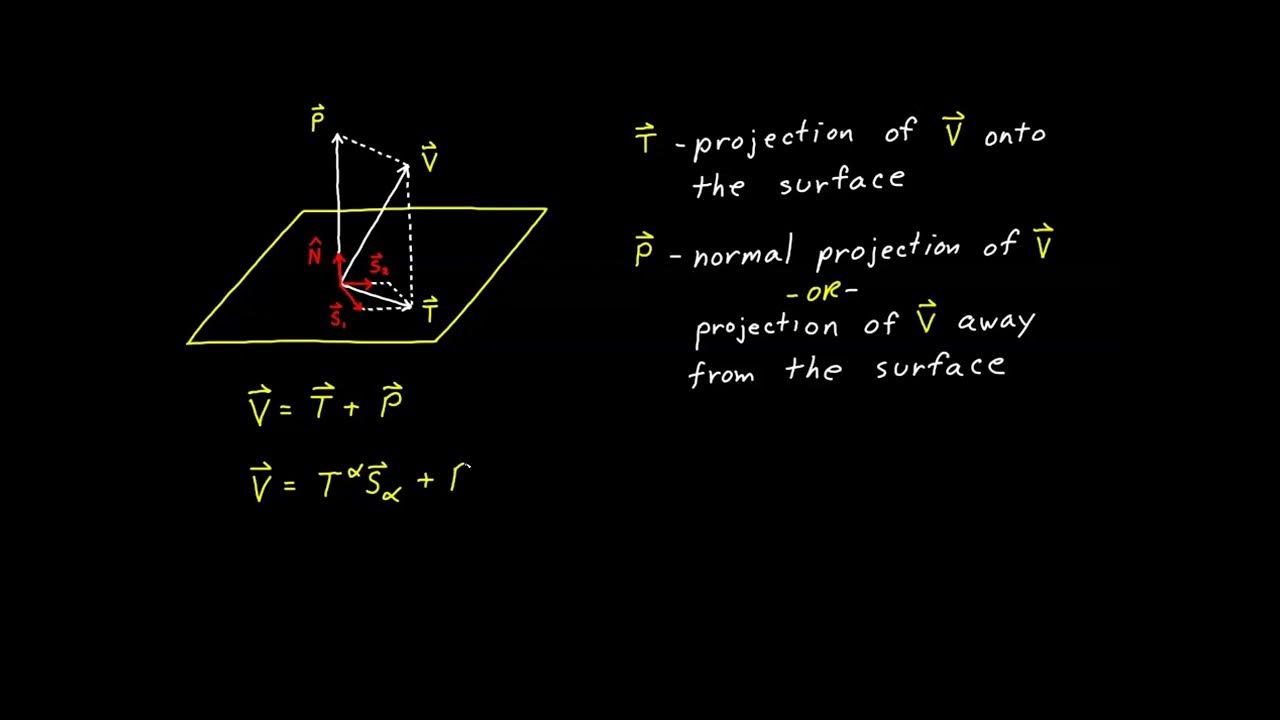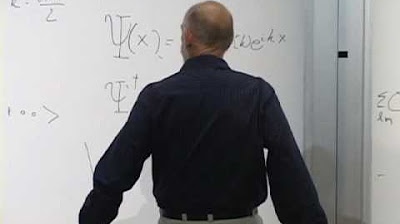Video 66 - Projection Operators
TLDRThis video introduces two tensor calculus objects, the normal and surface projection operators, which simplify the calculation of vector components for projections in space. The script explains how these operators work, their symmetrical properties, and their practical applications in 3D computer graphics for gaming and CAD software. It also explores several key identities, demonstrating how the operators can be applied to themselves, and concludes with an identity combining both operators to yield a delta function, highlighting their geometric significance.
Takeaways
- 📚 The video introduces two new tensor calculus objects known as projection operators: the normal projection operator and the surface projection operator.
- 🔍 The normal projection operator is defined as a second-rank tensor that projects a vector onto the normal of a surface.
- 📐 The surface projection operator is similarly a second-rank tensor that projects a vector onto the surface itself.
- 🔗 Both operators are symmetric second-rank tensors, meaning they can be interchanged without changing the resulting expression.
- 🧩 The normal projection operator can be represented as a 3x3 symmetric matrix, which simplifies the calculation of normal projection vector components.
- 📉 The contraction of the normal projection operator with itself results in the same operator, akin to the behavior of the delta function.
- 📈 The contraction of the surface projection operator with itself also results in the same operator, indicating repetitive application yields consistent results.
- ⚖️ The contraction of the indexes for the normal projection operator equals one, while for the surface projection operator, it equals the dimensionality of the surface (e.g., 2 for normal surfaces).
- 🔑 The sum of the normal and surface projection operators results in the delta function, which is a key identity in tensor calculus.
- 🎮 These projection operators have practical applications in computer graphics, such as in gaming and CAD software, for manipulating and displaying 3D objects on a 2D screen.
- 📝 The video concludes with an exercise for the viewer to derive an identity by simplifying the explicit definitions of the projection operators and using the identities involving the shift tensor.
Q & A
What is a normal projection operator in tensor calculus?
-A normal projection operator is a second-rank tensor that projects a vector onto the normal component of a surface. It operates on the vector components and outputs the components of the normal projection.
How is the normal projection operator represented mathematically?
-The normal projection operator is represented as \( P_{ij} \), which is a tensor formed by the product of the components of the normal vector \( n_i \) and \( n_j \).
What is the significance of the operator being symmetric?
-The operator is symmetric, meaning that flipping the indices \( i \) and \( j \) does not change the tensor. This implies that the corresponding matrix is symmetric, which has implications for the behavior of the projection.
What does the identity \( P_{ij} P_{jk} = P_{ik} \) signify?
-This identity shows that the normal projection operator, when applied multiple times, does not change. In other words, projecting a vector onto the normal component multiple times yields the same result as a single projection.
What is the surface projection operator and how does it differ from the normal projection operator?
-The surface projection operator \( T_{ij} \) projects a vector onto the surface itself rather than the normal component. It is formed by contracting the shift tensor components with the inverse of the shift tensor components.
How do you derive the surface projection operator?
-The surface projection operator \( T_{ij} \) is derived by combining the shift tensor \( Z_{i\alpha} \) and its inverse, which relate ambient and surface vector components.
What is the significance of the identity \( T_{ij} T_{jk} = T_{ik} \) for the surface projection operator?
-Similar to the normal projection operator, this identity shows that applying the surface projection operator multiple times yields the same result as a single application. It reflects the fact that the surface projection is idempotent.
How does the contraction \( P_{ii} = 1 \) relate to the properties of the normal projection operator?
-The contraction \( P_{ii} = 1 \) indicates that the normal projection operator, when summed over its indices, equals 1. This reflects the fact that the normal vector is a unit vector.
What is the combined identity involving both the normal and surface projection operators?
-The combined identity is \( \delta_{ij} = P_{ij} + T_{ij} \), where \( \delta_{ij} \) is the Kronecker delta. This identity indicates that the sum of the normal and surface projection operators reconstructs the original vector components.
How are these projection operators used in practical applications like computer graphics?
-In computer graphics and CAD applications, these operators are used to project 3D objects onto 2D screens. The surface projection operator helps in displaying 3D objects in two dimensions, allowing for realistic views and interactions.
Outlines
📚 Introduction to Projection Operators
This paragraph introduces the concept of projection operators in tensor calculus, specifically focusing on the normal and surface projection operators. The speaker discusses how these operators can be derived from existing expressions involving vector components and their projections. The normal projection operator is defined as a second-rank tensor that can be represented as a symmetric 3x3 matrix, simplifying the process of deriving the normal projection components from a given vector. The paragraph also highlights the importance of these operators in computer graphics and CAD applications, where they are used for projecting three-dimensional objects onto a two-dimensional screen.
🔍 Exploring the Normal and Surface Projection Operators
The speaker delves deeper into the properties of the normal and surface projection operators, explaining how they are defined and how they function. The normal projection operator is shown to be symmetric and to collapse into a single operation when applied to itself, similar to the delta function. The surface projection operator is introduced, which also operates on vector components to yield the components of the surface projection. The paragraph emphasizes the symmetry of these tensors and their utility in simplifying calculations in tensor calculus, particularly in the context of transformations and projections in three-dimensional spaces.
📘 Mathematical Identities of Projection Operators
This section explores the mathematical identities associated with the projection operators. The speaker demonstrates how the contraction of the normal projection operator results in a value of one, indicative of the dot product of a unit normal vector with itself. Similarly, the contraction of the surface projection operator yields a value that depends on the dimensionality of the surface, defaulting to two for normal surfaces. The identities highlight the self-replicating nature of these operators when applied consecutively, reinforcing the concept that applying the operator to its own result yields the same operator.
🎮 Practical Applications of Projection Operators
The paragraph discusses the practical applications of projection operators in computer programs, particularly in gaming software and CAD applications. These operators are essential for projecting three-dimensional objects onto a two-dimensional screen, allowing for realistic visualization and manipulation of 3D objects in a 2D space. The speaker emphasizes the significance of these operators in enabling the rotation, movement, and translation of 3D objects on a flat screen, contributing to the immersive experience in gaming and design software.
📝 Combining Projection Operators and Additional Identities
The final paragraph presents a combination of the normal and surface projection operators, leading to a new identity where the sum of these operators results in the delta function. This identity is expanded and explained, showing how it is consistent with the contraction of the ambient coordinates. The speaker also suggests an offline activity for the audience to practice working with these operators and their identities, recommending the simplification of an expression involving the normal vector components to derive and prove an additional identity.
Mindmap
Keywords
💡Tensor
💡Projection Operator
💡Normal Projection Operator
💡Surface Projection Operator
💡Second-Rank Tensor
💡Symmetric Tensor
💡Shift Tensor
💡Contraction
💡Delta Function
💡Unit Vector
Highlights
Introduction of two new tensor calculus objects known as projection operators.
Combining expressions to eliminate the value of p between two equations to define a new tensor calculus object.
Definition of the normal projection operator as a second-rank tensor involving two indexes.
The normal projection operator is symmetric and can be represented as a 3x3 square matrix.
Derivation of identities for the normal projection operator, such as p_ii being equal to the dot product of the normal vector.
The normal projection operator acting like a delta factor when contracted with itself.
Introduction of the surface projection operator, similar to the normal projection operator but for surface projections.
The surface projection operator is also a symmetric second-rank tensor.
Exploration of the surface projection operator's identity, where t_ii equals the dimensionality of the surface.
Geometric interpretation of applying the surface projection operator to vectors already lying on the surface.
Practical applications of projection operators in computer programs for gaming and CAD applications.
Combining the normal and surface projection operators to form the identity delta_ij = p_ij + t_ij.
Consistency check of the identity with the contraction of delta_i_i, p_ii, and t_ii.
Suggestion for an offline activity to practice working with the projection operators and their identities.
Recap of the video's content, summarizing the definition and properties of the normal and surface projection operators.
The significance of the projection operators in simplifying the process of finding normal and surface vector components.
Transcripts
Browse More Related Video

Video 67 - Projection Operator Examples

Video 65 - Tangent Space Transformations

Ch 9: What are Hermitian operators? | Maths of Quantum Mechanics

Calculus Chapter 5 Lecture 46 Differences II

Lecture 3 | New Revolutions in Particle Physics: Basic Concepts

Ch 7: How are observables operators? | Maths of Quantum Mechanics
5.0 / 5 (0 votes)
Thanks for rating: